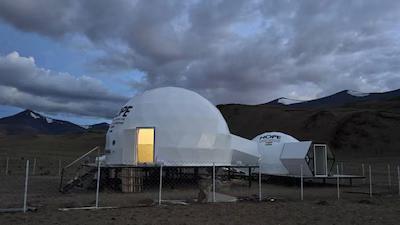
ISRO Sets Up Station in Ladakh to Simulate Life on Moon and Mars
The Indian Space Research Organisation (ISRO) has taken a significant step towards advancing its lunar and Martian exploration missions by setting up the Himalayan Outpost for Planetary Exploration (HOPE) in Ladakh’s Tso Kar Valley. The 10-day simulation mission, which began on August 1, will test life-support systems for future missions to the Moon and Mars. The unique valley was chosen for its extreme conditions, which are similar to those found on Mars, making it an ideal location to simulate life on the red planet.
Located at an altitude of 15,000 feet above sea level, the Tso Kar Valley is known for its high UV radiation, low atmospheric pressure, extreme cold, and saline permafrost. These conditions are eerily similar to those found on Mars, making it an ideal location for ISRO to test the life-support systems of its future lunar and Martian missions.
The HOPE station, which is a miniaturized version of the habitats that will be used on future missions, will be occupied by two crew members from August 1 to 10. The crew will undertake various tests and experiments to simulate life on the Moon and Mars. The tests will focus on the psychological and physiological effects of prolonged exposure to the extreme conditions, as well as the performance of the life-support systems.
The life-support systems being tested at the HOPE station include air recycling, water recycling, and waste management. The systems will be used to sustain the crew for extended periods, just like they will on future missions to the Moon and Mars. The crew will also be required to perform various tasks, such as maintaining the station, conducting scientific experiments, and monitoring the systems.
The HOPE station is a significant step forward for ISRO’s plans to explore the Moon and Mars. The organisation has been working towards sending its first manned mission to space by 2022, and the HOPE station is a crucial step in that journey. The data and insights gathered from this simulation mission will be used to refine the life-support systems and habitats that will be used on future missions.
The Tso Kar Valley was chosen for the HOPE station due to its extreme conditions, which are similar to those found on Mars. The valley is located in a remote and inhospitable region, with temperatures often dropping below -20°C and winds reaching speeds of over 100 km/h. The high altitude and low atmospheric pressure also make it an ideal location to simulate the low air pressure found on Mars.
ISRO has been working towards exploring the Moon and Mars for several years now, and the HOPE station is a significant milestone in that journey. The organisation has already successfully launched several missions to the Moon and is planning to send its first manned mission to space in the near future.
The HOPE station is a testament to ISRO’s commitment to advancing space exploration and contributing to the global effort to explore the Moon and Mars. The data and insights gathered from this simulation mission will be crucial in refining the life-support systems and habitats that will be used on future missions.
In conclusion, the Himalayan Outpost for Planetary Exploration (HOPE) station in Ladakh’s Tso Kar Valley is a significant step forward for ISRO’s plans to explore the Moon and Mars. The simulation mission, which began on August 1, will test life-support systems for future missions to the Moon and Mars. The unique conditions in the Tso Kar Valley make it an ideal location to simulate life on the red planet, and the data and insights gathered from this mission will be crucial in refining the life-support systems and habitats that will be used on future missions.






